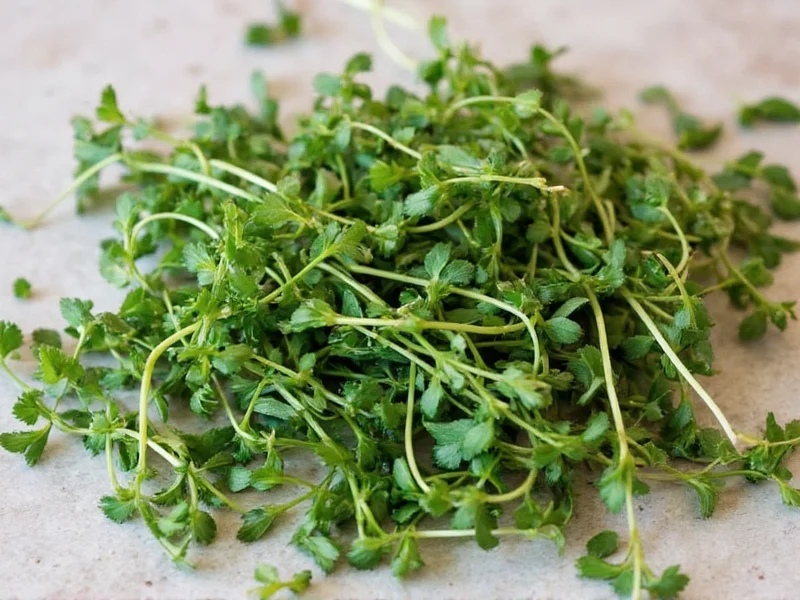When you're in the middle of cooking and realize you're out of thyme, knowing reliable thyme substitutes can save your recipe. Thyme's distinctive earthy, slightly minty flavor with subtle lemon notes makes it a staple in many cuisines, particularly Mediterranean and French cooking. Understanding what makes thyme unique helps identify the best replacement options for your specific culinary needs.
Understanding Thyme's Flavor Profile
Before selecting a substitute, it's important to understand what you're trying to replicate. Fresh thyme offers a delicate balance of earthiness with subtle floral, minty, and lemon undertones. Dried thyme concentrates these flavors, becoming more potent and slightly more medicinal in taste. The best substitutes will match either the earthy component or the citrus notes depending on your recipe's requirements.
Top Substitutes for Thyme in Cooking
Not all thyme alternatives work equally well in every dish. Here's a comprehensive guide to help you choose the perfect substitute based on your specific cooking needs.
| Substitute | Best For | Substitution Ratio | Flavor Notes |
|---|---|---|---|
| Oregano | Pasta sauces, pizza, tomato-based dishes | 1:1 (dried) | More pungent, less citrusy; best dried thyme substitute |
| Marjoram | Chicken, fish, vegetables, soups | 1:1 (fresh or dried) | Sweeter, milder; closest flavor match to thyme |
| Summer Savory | Bean dishes, stews, stuffing | 1:1 | Peppery with subtle thyme-like notes |
| Rosemary | Lamb, roasted meats, potatoes | ½:1 (use half amount) | Stronger, pine-like; use sparingly as thyme replacement |
| Herbes de Provence | Mediterranean dishes, roasts | 1:1 | Contains thyme plus complementary herbs |
Detailed Substitute Analysis
Oregano: Best Overall Substitute
Oregano makes an excellent thyme substitute, particularly in Italian and Mediterranean dishes. While oregano has a stronger, more pungent flavor than thyme, it shares similar earthy characteristics. When substituting oregano for thyme in tomato-based dishes, pasta sauces, or pizza, use an equal amount of dried oregano for dried thyme. For fresh applications, oregano works well but has a more robust flavor, so you might want to use slightly less. This is particularly useful for those searching for thyme substitute for spaghetti sauce or best thyme replacement in pizza.
Marjoram: Closest Flavor Match
Marjoram is actually in the same botanical family as thyme and offers the most similar flavor profile. It's slightly sweeter and milder than thyme, making it perfect for delicate dishes where you don't want the herb to overpower other ingredients. Marjoram works exceptionally well as a 1:1 substitute in chicken recipes, vegetable dishes, and soups. Many professional chefs consider marjoram the best fresh thyme substitute when preparing dishes like thyme substitute for roast chicken or alternative to thyme in vegetable broth.
Summer Savory: The Underrated Option
Often called the "bean herb," summer savory provides a peppery flavor with subtle thyme-like notes. It works particularly well in bean dishes, stews, and stuffings where thyme would normally be used. The substitution ratio is straightforward at 1:1, making it easy to use when you're in the middle of cooking. Summer savory makes an excellent thyme replacement in three-bean salad or substitute for thyme in lentil soup.
Rosemary: Use with Caution
Rosemary has a much stronger, pine-like flavor compared to thyme, so it should be used more sparingly as a substitute. When replacing thyme with rosemary, use only half the amount called for in your recipe. This works best in robust dishes like roasted meats, particularly lamb, or hearty potato dishes. Rosemary makes a suitable thyme alternative for roasted potatoes but would overwhelm more delicate dishes like fish or egg-based recipes.
Dried vs. Fresh Thyme Substitutions
Understanding the difference between dried and fresh herb substitutions is crucial for recipe success. Dried herbs are typically more concentrated than fresh, with a general rule that 1 teaspoon dried herb equals 1 tablespoon fresh herb. However, when substituting one dried herb for another (like dried oregano for dried thyme), a 1:1 ratio usually works well.
For fresh herb substitutions, the ratios are more nuanced. When replacing fresh thyme, marjoram is the closest match at a 1:1 ratio. Oregano can be used fresh as a substitute but has a stronger flavor, so you might want to use ¾ the amount of fresh oregano compared to fresh thyme. This distinction is particularly important for those searching for fresh thyme substitute dried or what to use instead of fresh thyme in salad dressing.
Creative Substitution Combinations
Sometimes the best thyme substitute isn't a single herb but a combination. For example:
- For Mediterranean dishes: Combine equal parts oregano and marjoram
- For French cuisine: Use a pinch of tarragon with marjoram
- For robust meat dishes: Mix rosemary (¼ part) with oregano (¾ part)
- For delicate fish recipes: Use marjoram with a tiny pinch of lemon zest
These combinations can help replicate thyme's complex flavor profile more accurately than a single substitute herb. This approach works well for specific needs like thyme substitute for coq au vin or best herb replacement for thyme in bouillabaisse.
When Substitutes Won't Work
While most recipes can accommodate thyme substitutes, some dishes rely specifically on thyme's unique flavor. Traditional Herbes de Provence blends, certain French sauces, and some meat marinades might not achieve the same results with substitutes. In these cases, consider making a quick trip to the store or adjusting your recipe rather than using an unsuitable substitute.
Practical Tips for Successful Substitutions
- Add substitute herbs later in the cooking process than you would thyme, as many substitutes have more delicate flavors
- Taste frequently and adjust seasoning as needed
- For dried herb substitutions, crush them between your fingers before adding to release more flavor
- When substituting in baking or delicate dishes, start with less than the recommended amount and adjust to taste
- Consider the dish's cooking time—longer cooking times require more robust substitutes like oregano rather than delicate ones like marjoram











 浙公网安备
33010002000092号
浙公网安备
33010002000092号 浙B2-20120091-4
浙B2-20120091-4